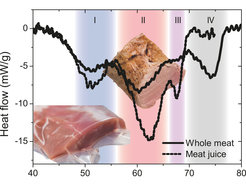Protein physics based sous-vide cooking of muscle meat: how to perpare tender and juicy (pork) filets
Professor Thomas Vilgis, Project Leader at the Max Planck Institute for Polymer Research in Mainz, and his team look into protein denaturation of meat using a sous-vide technique. Their results have now been published in Food Biophysics and should help you prepare delicious pork filets.
This study systematically investigates the impact of time (10 minutes – 48 hours) at different cooking temperatures (45 – 74°C) on the state of protein denaturation and water content of a cooked piece of meat. The scientists used the so-called DSC (Differential Scanning Calorimetry) method in order to perform the measurements. This is the first study to address such a broad range of times and such well-defined temperatures. This is particularly important since every muscle protein denatures at a precisely defined temperature.
“This study has important gastronomical implications: it discredits a common belief. Cooked meat had long been held warm until serving. It was thought that maintaining meat at a constant temperature was better than reheat it. This study now shows that the ongoing protein denaturation over a long period of time might lead to undesired properties such as a lack of tenderness or juiciness”, explains Thomas Vilgis.

Upon heating muscle and connective tissue lose their native molecular shape or conformation. It causes a change in the texture. Above 60°C, muscle meat loses the bigger part of its water. It gets hard, tough and fibrous. Between 48°C and 71°C, different proteins gradually change shape. They shrink, form close meshed networks or coagulate. Factors such as juiciness or tenderness change to the same extend. Sous-vide cooking enables to best control the exact temperature and thus the associated properties.
The sous-vide technique is a common cooking method used in the gastronomy. Food is sealed in an airtight plastic bag then placed in a water bath at a well-defined temperature. The aim is to cook the item evenly, ensuring that the inside is properly cooked without overcooking the outside, and to retain moisture. Fresh meat contains about 75% of water. Yet cooking meat is a complex process. The water holding capacity of meat as well as the water loss changes at high cooking temperature. By controlling the denaturation state of meat proteins using sous-vide cooking, the meat will remain tender and juicy. Selective denaturation of meat proteins is essential to reach the desired textures. Please remember: the loss of meat juices increases with time and temperature. The main water loss, for its part, occurs during the first 20 minutes and at temperatures above 60°C. In the end, to obtain the best pork filet (average sized), cook it sous-vide for 20 minutes at 55°C.












